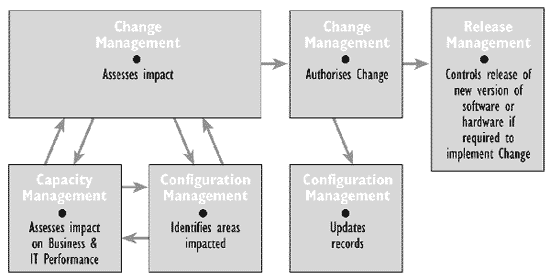Configuration Management is an integral part of all other Service Management processes. With current, accurate and comprehensive information about all components in the infrastructure the management of Change, in particular, is more effective and efficient. Change Management can be integrated with Configuration Management. As a minimum it is recommended that the logging and implementation of Changes be done under the control of a comprehensive Configuration Management system and that the impact assessment of Changes is done with the aid of the Configuration Management system. All Change requests should therefore be entered in the Configuration Management Database (CMDB) and the records updated as the Change request progresses through to implementation.
The Configuration Management system identifies relationships between an item that is to be changed and any other components of the infrastructure, thus allowing the owners of these components to be involved in the impact assessment process. Whenever a Change is made to the infrastructure, associated Configuration Management records should be updated in the CMDB (see Figure 2.1). Where possible, this is best accomplished by use of integrated tools that update records automatically as Changes are made.
The CMDB should be made available to the entire Service Support group so that Incidents and Problems can be resolved more easily by understanding the possible cause of the failing component. The CMDB should also be used to link the Incident and Problem records to other appropriate records such as the failing Configuration Item (CI) and the User. Release Management will be difficult and error prone without the integration of the Configuration Management process.
The Service Delivery processes also rely on the CMDB data. For example:
Figure 2.1 shows sample relationships between Configuration Management and other Service Management processes.

Figure 2.1 - Relationship between Capacity Management, Change Management, Configuration Management and Release Management